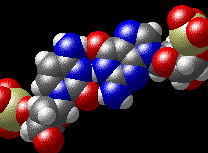
DNA Structure Activity
Problem 8: Structure of GC and AT base pairs.
Return to the views labeled "C11-G33 base pair" and "T9-A35 base pair". As first suggested by Watson and Crick, the nitrogen-containing "bases" of DNA interact to form base pairs via hydrogen bond interactions. A pairs with T, and G pairs with C. One technique to visualize H-bonds is to switch between ball-and-stick and space filling mode (using the Toolbar buttons), and note the overlap of the white hydrogen atoms with the nearby electronegative oxygen (red) or nitrogen (blue) atoms. The number of hydrogen bonds between the C11-G33 and T9-A35 base pairs are ______ and _______, respectively.
Tutorial

|
A hydrogen bond can form when a hydrogen atom is covalently bonded to one electornegative atom (either nitrogen or oxygen in DNA), and comes in close proximity to another electronegative atom. In space filling mode, hydrogen bonds appear as shown in the center of the illustration to the left with a hydrogen atom overlapped with two electronegative atoms. In this picture from the "C11-G33 base pair" view recorded in spacefilling mode, there are three hydrogen bonds. From top to bottom, note N-H...O, N...H-N, and O...H-N. When an AT base pair, such as the "T9-A35 base pair", how many hydrogen bonds do you detect? |
University of Arizona
Modified: May 27, 1997
Contact the Development Team
http://biology.arizona.edu
All contents copyright © 1997. All rights reserved.